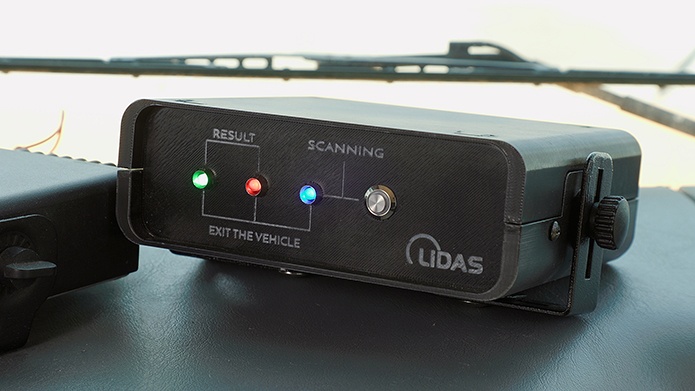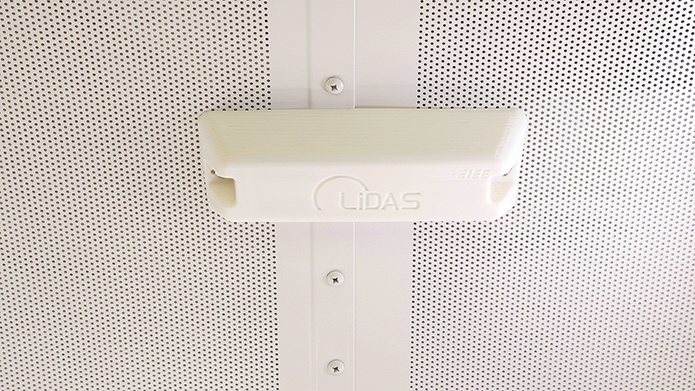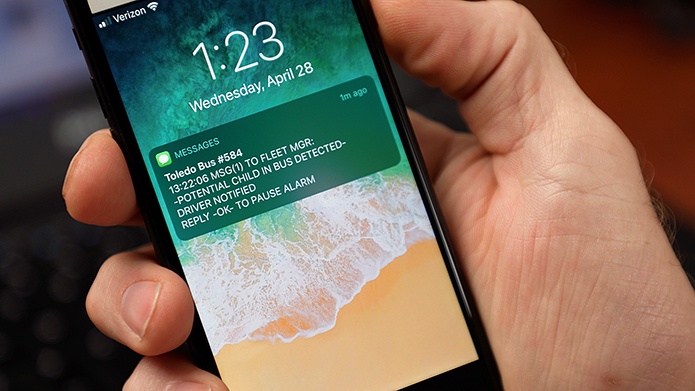
After a long day (and despite the school bus industry’s exceptional safety record), children are sometimes left behind on the school bus. Best practices, surveillance systems, and training help a lot — but is there more you can do to ensure every kid is off the bus each night?
No school bus driver intends to leave a child on their vehicle at the end of a long day. But despite the best training, efforts, and intention from dedicated professionals nationwide, this unfortunate situation still happens too often. Training, surveillance systems, and best practices all go a long way – but are you doing everything you can to ensure each kid is off the bus each night?
That question is what lead IEE Sensing and Dr. Joseph Funyak, senior vice president of transformative products and technologies, to develop LiDAS, or Life Detection Assistance System. LiDAS is described as a turnkey child detection system which automatically recognizes children (or any living being) accidentally left behind on school vehicles.

Origins in Automotive Safety
The technology behind LiDAS began in the automotive world with VitaSense, a radar sensor developed by IEE Sensing in 2009 to detect infants and children left behind in hot cars.
“We created an onboard sensor with the capability to detect even the faintest breathing from a six-month-old infant, even with a blanket covering their head,” Funyak said. “That sensor is being rolled out to passenger cars, but it presented an interesting question – what about school buses, where the number of children is multiplied many times?”
In 2017, IEE Sensing began developing LiDAS for school buses. Funyak observed that school buses were very safe thanks to surveillance technology and driver checks, but the industry lacked an automated solution to protect against the event of a child being left behind on a bus.
“I thought it was important for school districts to have a standalone, automatic system to check for children,” he said. “There is no way for the driver to circumvent the system, and it provides an independent check against human error.”
Funyak noted that even experienced drivers can sometimes miss a child due to habitual memory triumphing over prospective memory.
“When a school bus driver searches their bus after each run, day after day, in search of children left behind, they form habitual memory — that no children are found on the bus,” Funyak said, citing a 2019 study by Dr. David Diamond at the University of South Florida. “Now add a change of some sort or a distraction and the prospective memory – like searching the bus for children left behind – can fail.”

LiDAS
When installing the system on a school bus, IEE Sensing first places radar sensors around the vehicle equipped with a patented pattern recognition software. IEE partnered with Brandmotion to be the primary installer of LiDAS as it ramps up into higher production volumes. Brandmotion, experts on installing state-of-the-art technology in the transportation market, have helped with ideas and improvements regarding the installation of LiDAS into school buses.
“It is critical for us to provide support when LiDAS goes to a new school district,” said Jeff Varick, CEO and founder of Brandmotion. “Districts are busy enough and do not have the necessary expertise to install the system, monitor, and support it. We have 175 technicians across the country who can help – while also making the installation process better, faster, and more affordable for school districts.”
IEE and Brandmotion also equip the bus with a central control unit (CCU) with a wireless communication modem, and a driver interface at the front of the bus. This interface provides the driver with system status, and the system’s notifications are customizable – including alarms, horn activation, flashing lights, and text messages. The control unit connects directly to the cloud, providing districts with real-time system communication and data storage savings.
That control unit for LiDAS was developed and manufactured by BGM Engineering. BGM assisted in optimizing the design of the CCU and will also produce and assemble the complete Integrated Driver Interface with CCU.
“IEE had a prototype of the controller, which we optimized into a robust, vehicle-ready control board for LiDAS,” said Joe Mazur, VP of engineering for BGM Engineering. “School buses run for long periods, and sometimes in extreme temperatures and over a lot of vibration. This unit is rugged-ready for the many miles placed on school buses.”
Funyak said LiDAS allows for customizable settings like detection escalation cyclic, or pre- and post-route checks – all depending on a district’s unique needs.
When a driver turns on the vehicle’s ignition, LiDAS goes into standby mode. When the ignition is switched off, the LiDAS activates after a preset delay time (for post-route driver tasks). In about one minute, the system scans the entire bus and sends out a predetermined notification to the appropriate district contact.
“The system will detect a child even if they are sleeping under a seat bench in the dark,” Funyak said. “It is not reliant on lighting. It sees through seats and is not affected by mechanical disturbances.”
All results are sent to a cloud-based storage for retrieval and review on a real-time basis.
St. Clair Technologies (SCT) assisted IEE Sensing in designing and optimizing the various wire harness and cable configurations for LiDAS. SCT’s market focuses include bus, automotive, military, RV, truck, H-D equipment, marine, power sports, alternative energy and more.
“When IEE came to us, there was a basic idea of how the system should function,” said Sharon Azuara, SCT account manager. “We worked with IEE to develop the connection systems, how it could be fed through the buses, and worked to develop the wiring to run the system.
“Even in today’s world, children are still unfortunately left behind from time to time,” said Barry Grobosky, vice president of engineering for SCT. “Many of the preventive systems in place are based on people completing a process, whereas this sensor array provides an automatic check.”
“The entire industry is trying to make smarter systems,” said SCT CEO Charlie Hess. “As this technology progresses, the LiDAS system will become more intelligent than it is today.”

Beginnings in Pupil Transportation
For early adopters of LiDAS, Funyak began locally in his home state of Michigan. After some investigating he found Mac Dashney, then-executive director of the Michigan Association for Pupil Transportation (MAPT) and former director of pupil transportation for Michigan’s Lansing School District. Combined with his other positions at various levels, Dashney’s education career spans nearly 50 years.
Dashney quickly saw the value for LiDAS and became an early champion for the system.
“The information overload that school bus drivers have to deal with is incredible,” Dashney said. “At bus stops, keeping track of 60 kids or more, keeping track of what’s going on during a trip, keeping track of offloading – it adds up to a lot of potential distractions.”
“When Joe Funyak showed me the system,” he said, “I immediately thought of several innovative districts in the area who might be interested in this technology.”
Dashney put Funyak and IEE Sensing in touch with Dave Meeuwsen, director of Zeeland Public Schools at the time. Zeeland Public Schools’ district covers 94 square miles in Western Michigan. Meeuwsen retired in July 2021 and is the current executive director of MAPT.
Through rigorous use and testing, Funyak said, Zeeland helped develop what LiDAS is today
“Our partnership with LiDAS was built upon the desire to be more proactive about student safety,” Meeuwsen said. “At the same time, technology like this can help save drivers from some scary situations.”
IEE outfitted a few Zeeland Public Schools buses with early versions of LiDAS in 2018, with the district helping to test, review, optimize the detection system.
“The LiDAS rollout was really great, with IEE and our technicians working very closely on installation and maintenance,” Meeuwsen said. “They also worked with our state police to make sure it meets their expectations for installation.”
“Zeeland is on the forefront of new technologies as they come out,” Funyak said. “The initial prototype for Zeeland was much leaner in features than the current system. Their collaboration was instrumental in bringing LiDAS to where it is today.”
The system saw further adoption when Funyak met Brad Aemisegger at the 2018 MAPT Annual Conference. Aemisegger is the director transportation for Toledo Public Schools in Ohio and was representing the NAPT Executive Committee at the Michigan conference.
Aemisegger told Funyak that, once LiDAS had completed its testing phase in Michigan, there was potential interest for the system in Ohio.
“I liked that this product eliminated the human error element in checking for kids,” he said. “If we had unlimited funds, I would outfit every bus in our fleet.”
Currently, about 10 percent of the district’s 160-vehicle fleet are equipped with LiDAS. Aemisegger said that Toledo Public Schools will continue to purchasse and install LiDAS system by system, vehicle by vehicle as budget allows.
“This is a system where you hope to never need it,” he
said. “But if you do need it, you can save a child from potential harm.”
No Child Left Behind
Funyak said that, more than anything, he hopes LiDAS can act as part of a holistic system to prevent children being left on a bus.
“Dating back to our experience in the automotive world, it is devastating to hear parents talk about children they’ve lost due to a simple mistake,” he said. “With school buses, we have many systems and pieces of technology intended to remind us about checking for kids – but not a singular, automatic solution. That is how we can solve this problem.”


